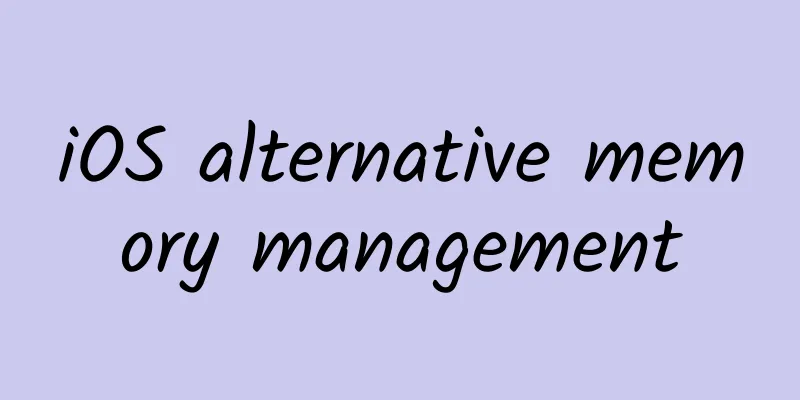iOS alternative memory management

|
OS memory management is a commonplace issue. When we write iOS, we are always involved in memory management. From the beginning of MRR (manual retain-release) to the later ARC (Automatic Reference Counting), including CoreFoundation's memory management, all follow the basic principle of reference counting. Everyone must be familiar with basic memory management. I will mainly talk about it here and not say much about the rest. The official document has this paragraph - You own any object you create You create an object using a method whose name begins with “alloc”, “new”, “copy”, or “mutableCopy” (for example, alloc, newObject, or mutableCopy). The general idea is that if you create an object using methods starting with alloc/new/copy/mutableCopy, then you will own the object (retain). When you don't need it, you need to release it manually. For example, suppose there is a method, [STObject newObject] We should use it like this. If we don't release it, the Object will be leaked.
In this case, we can also imagine that if we want to implement the method starting with new ourselves, we need the following code
Then the following questions arise: A newObject method is implemented under MRR. This method follows the agreed principle and the return value will retain+1. Then, this method is called under ARC to create an object. A newObject method is implemented under MRR. This method does not follow the convention principle and returns an autorelease object. Then, this method is called under ARC to create an object. A newObject method is implemented under ARC, and then the newObject method is called under MRR to create an object and release it after use. A newObject method is implemented under ARC, and then the newObject method is called under MRR to create an object, but there is no release after use. We can write the above experimental code ourselves and then test it. The final test results are as follows: Scenarios 1 and 3 run normally In scenario 2, the system will crash. Memory leak occurs in scenario 4 Why does scenario 2 crash? This is because under ARC, if our compiler sees that you created an object with a method starting with alloc/new/copy/mutableCopy, it will insert a release operation at the beginning of the use. Since the object returned is an autorelease object, it is released again, resulting in a wild pointer. The reason for the leak in scenario 4 is the same. When the compiler under ARC finds that the method starts with new, it will not insert a release statement at the end of the method. During the use of scenario 4, newObject is not released, so a leak will occur. If we only use MRR or ARC, this problem will not occur. This problem usually occurs when ARC/MRR is mixed, due to some non-standard writing, so it is necessary to comply with the standards in the process of writing code. If we write our own methods starting with alloc/new/copy/mutableCopy, we must not forget to return the retained object under MRR. Similarly, when we use alloc/new/copy/mutableCopy methods to create objects, we must not forget to release them after use. If we have a piece of MRR code that provides a method starting with new but does not follow the specification, what should we do under ARC? According to the above conclusion, our normal use will definitely lead to wild pointers. Here, if we can change the code, we will change it to comply with the standard. If we cannot change the source code, we can only modify the user. Here is a method:
You can try it and then think about why. There is much more to iOS memory management than this. What is mentioned in this article is rarely encountered in the actual coding process. It is just a supplement to knowledge. |
<<: How to learn Android development? Android information sharing
>>: NULL and nullptr and nil and Nil and NSNull
Recommend
WOT + Heroes Gathering, a feast that technical people cannot miss in 2018
Nowadays, facing the trend of digital transformat...
Morgan Stanley: India will become Apple's next China
China's economic growth, the increase in the ...
XISE China Chopper V14.0 cracked version without backdoor - Feng Chao's blog
For SEO website optimizers, we not only need to l...
What is a healing speaker? It can feel your mood
We all know that light and music have a great inf...
From the article about Pechoin that goes viral, let’s discuss whether the advertisement that goes viral should be related to sales.
A few days ago , Pechoin’s one-shot advertisement...
This Apple commercial was all over the screen on the first day of the Spring Festival travel rush!
Why did a Spring Festival travel blockbuster shot...
How to distinguish "double positive" from influenza A? Can they be infected at the same time? Experts explain →
At the press conference of the Joint Prevention a...
A review of the 2015 BAT campus recruitments: some increases and some decreases
It is the beginning of another school year, and i...
my country has discovered a new COVID-19 drug and obtained a patent! It is extracted from this plant! Many people have seen it, but they can't name it.
Expert of this article: Li Ting, Master of Plant ...
China Automobile Dealers Association: Passenger car new four modernizations index is 64.2 in October 2020
The Passenger Car New Four Modernizations Index, ...
No creativity in video promotion? This article teaches you!
Since the second quarter of 2018, the education i...
How to promote APP and attract new users?
How to promote a primary APP? I personally think ...
Zhejiang's pneumonia epidemic emergency response has been adjusted to level two! What is the difference between level one and level two?
Recently, the total number of cured and discharge...
Android GO system is developing slowly: only a dozen apps are available
At the Google I/O conference in 2017, Google anno...









